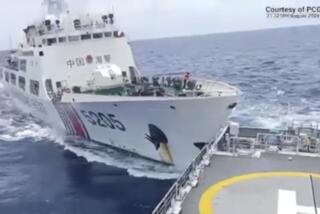Encounters Routine for U.S. Patrol Missions
- Share via
WASHINGTON — For five decades, American planes have been flying patrol missions off the Chinese coast, U.S. military experts say--and China’s air force has been regularly sending its own aircraft to watch them.
But never before have these routine, little-publicized military maneuvers resulted in a collision or an emergency landing like the one Sunday, in which a U.S. military plane sounded a mayday and landed on China’s Hainan island and the Chinese craft apparently crashed.
“When I first heard about this, I was so shocked I thought it might be an April Fools’ joke,” said retired Rear Adm. Eric McVadon, a former U.S. defense attache in Beijing who for 25 years flew military planes similar to the one involved in Sunday’s incident.
Another former U.S. military attache in China, who declined to be named because his employer does not let him speak to the media, explained that pilots who fly the U.S. patrol missions expect the Chinese air force to send its planes in response.
“That’s one of the purposes of our flying these aircraft, to see how they [the Chinese] scramble us, to see how we do,” he said. “It’s not just against China--we do this around the world.”
Usually, however, when the People’s Liberation Army sends planes to the area of the American patrols, the Chinese aircraft remain a short distance away. What exactly caused Sunday’s collision was unclear, though U.S. officials said it appeared to be the result of an accident.
The type of aircraft involved in the emergency landing is a P-3, a four-engine propeller plane. Generally, P-3s are used for routine maritime patrols and for anti-submarine warfare.
The plane that landed Sunday was an EP-3, a P-3 specially outfitted with equipment to collect intelligence from Chinese military communications. (The E in the name stands for “electronic.”)
Despite the frequency of the U.S. patrols and Chinese counter-patrols, there has not been any confrontation between the two militaries for more than six years.
In late October 1994, the U.S. aircraft carrier Kitty Hawk and a Chinese nuclear submarine squared off in the Yellow Sea over a three-day period.
No shots were fired, but the Kitty Hawk sent anti-submarine warfare planes to track the sub, and Chinese jet fighters flew within sight of the U.S. planes. Afterward, a U.S. military official in Beijing was warned that if such an incident occurred again, China’s orders would be to shoot to kill.
The Kitty Hawk confrontation, which U.S. officials kept secret until it was revealed by The Times, was sufficiently worrisome that the U.S. and Chinese governments negotiated an agreement aimed at preventing accidents or inadvertent clashes at sea.
Pact Intended to Cover Ships
The pact, known as the Military Maritime Consultation Agreement, was signed by then-Defense Secretary William S. Cohen in Beijing in 1998. But it covers mostly warships, not patrol aircraft like the one involved in Sunday’s collision.
“It’s very clear that these are two militaries [the United States and China] that are going to have closer and closer proximity to one another in the maritime regions of the Pacific, especially in the South China Sea,” said David Finkelstein, a former Pentagon official who now works for CNA Corp.’s Center for Strategic Studies.
Finkelstein suggested that the 1998 agreement should be expanded in a way that would avert conflict between aircraft as well as warships.
“This [collision] underscores the importance of having mechanisms to deal with issues like this,” he said.
Several U.S. military experts said they were convinced that the collision was the result of a mistake rather than a deliberate act by the Chinese.
They reasoned that if Beijing had wanted to create some sort of diplomatic confrontation with the United States, it would have forced the U.S. plane to land, rather than bumping it in midair.
“The way to create an incident is not to have two aircraft brush against each other,” said McVadon, the former attache. “The outcome is too unpredictable. You’re asking someone [a Chinese pilot] to do a kamikaze mission. How can you be sure there won’t be enough damage for the Chinese plane to crash?”
Even though the midair collision seemed to have been accidental, U.S. military experts cautioned that there could be an intense diplomatic confrontation if China tried to go inside the American aircraft on the ground.
“It’s a reconnaissance aircraft, and so they [Chinese military experts] might want to get on board and see what’s there,” said the former U.S. military attache who asked not to be identified. “But that aircraft is sovereign U.S. territory.”
Earlier Incident Involved U.S. C-5
U.S. officials say there was a brief, undisclosed diplomatic contretemps between America and China in 1988 when local officials in the Manchurian city of Shenyang sought to board an American C-5 aircraft. The plane was in China on an exercise as part of the extensive military cooperation that existed between the countries during the Cold War.
At that time, U.S. officials objected strenuously at high levels, and China backed down.
One of the underlying issues in Sunday’s collision is whether the U.S. plane was in international airspace, more than 12 miles off China’s coast.
That issue could be somewhat more complicated than a sheer matter of distance, because China has large territorial claims to the South China Sea--claims that many other nations, including the United States, do not recognize.
U.S. military officials said the collision took place about 50 nautical miles from Hainan. In its initial statements, the Chinese Foreign Ministry gave the distance as 62 miles from the island.
But listing the distance from Hainan skirts the question of exactly how China defines its international airspace and whether Beijing might claim that the U.S. plane intruded too close to Chinese territory.
More to Read
Sign up for Essential California
The most important California stories and recommendations in your inbox every morning.
You may occasionally receive promotional content from the Los Angeles Times.









